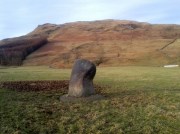Standing Stone: OS Grid Reference – NS 56929 79402
Also Known as:
From Strathblane, take the A891 road eastwards out of the village, past the standing stone in the churchyard and the row of houses set back off the road until, a few hundred yards along, the fields open up on both sides of you. In the very first field on the north side of the road, you’ll see the standing stone, all alone, resting quietly. There’s a gate enabling you access into the field…
Archaeology & History
Found in close proximity to the destroyed chambered tomb of Broadgate, this small standing stone is presently set in a concrete base after an excavation here in 1982 located a cremation urn beneath the stone, confirming an old tradition that told as much. But there are some who think the stone isn’t a prehistoric one—the Royal Commission (1963) lads for one. In their brief resumé of the site they wrote:
“This stone stands just N of the road from Campsie to Strathblane, 140 yds E of Broadgate farmhouse. It is 4ft high and measures 2ft 3inches by 3ft at ground level. It may well be the stone referred to in the New Statistical Account as marking the spot where Mr Stirling of Ballagan was murdered in the 17th century and should therefore not necessarily be accepted as of prehistoric origin.”
And were it not for an excavation nearly twenty years later, this view may have been maintained. However, when Lorna Main (1982) told of what was found beneath the monolith, no mention was made of any recent remains. She wrote:
“Excavation at the base of the fallen standing stone was undertaken prior to its re-erection. A ledge had been cut on the south-west side of the shallow stone hole and fragments of the base survived and the diameter of the base is approximately 17cm. The urn contained a cremation and a small quantity of charcoal. It lay only 15cm below the ground surface and is in a poor condition.”
The very fragile state of the urn and the very eroded rounded stature of the rock itself would seem to indicate that this is more a prehistoric upright than a later 17th century one.
Folklore
There are legends of early battles in this region and J.G. Smith (1886) thought that perhaps “this great stone…mark the resting-places of Cymric heroes who did their share of the battle on the north side of the valley.”
References:
- Main, Lorna, “Broadgate Farm – Standing Stone and Cinerary Urn,” in Discovery & Excavation Scotland, 1982.
- Royal Commission on the Ancient & Historical Monuments Scotland, Stirling – volume 1, HMSO: Edinburgh 1963.
- Smith, John G., The Parish of Strathblane, James Maclehose: Glasgow 1886.
- Ure, David, The History of Rutherglen and East Kilbride, Glasgow 1793.
© Paul Bennett, The Northern Antiquarian
The map could not be loaded. Please contact the site owner.

